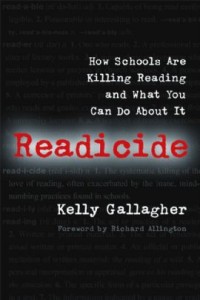 I’m forgoing the picture book pick this week because I’ve just finished reading Readicide: How Schools are Killing Reading and What You Can Do About It by Kelly Gallagher and I need to talk about it with my education peeps.
I’m forgoing the picture book pick this week because I’ve just finished reading Readicide: How Schools are Killing Reading and What You Can Do About It by Kelly Gallagher and I need to talk about it with my education peeps.
I put off reading Readicide at first because of the subtitle “how schools are killing reading”. I know so many educators pouring every ounce of their energy into our students, and as someone with over 20 years of working with students, I took the title as yet another criticism of teachers. Gallagher, however, is a classroom teacher himself, and his indictment is not of those of us in the trenches so much as a call to reevaluate an educational system that focuses on test scores instead of lifelong learning.
For me, the big “yes!” points were:
1. Our kids need a variety of interesting fiction and nonfiction books, magazines, articles, etc. and time in school to read for enjoyment. We librarians are dedicated to getting great reading material in the hands of kids, so if you have a tough student who doesn’t seem interested in reading anything, call a librarian – we’ll hook you up.
2. Reading is more than just decoding the words on the page – prior knowledge is key to understanding. I consider myself to be good at reading, but put an installation manual for an appliance in front of me and I’m quickly stumped. I know what each word means (I think) and yet I don’t have the experience to get how it all goes together. Our kids need what Gallagher calls “a broad knowledge base” to succeed, and so we need to read aloud historical fiction, science, poetry, etc. and discuss of all kinds of topics. We can bring in lots of “real-world text” like magazines, speeches, essays, editorials, news stories (in paper or electronic form from reliable resources).
3. Just like movies have trailers to draw in audiences, a good booktalk can hook readers who’d otherwise pass up a great book. Simply having the books on my shelves won’t pull in every kid. It’s worth my time to “sell” books to individuals and classes.
The book is packed with facts and practical information but still is a quick read. I highly recommend picking it up this summer. It’s not a light-hearted beach read, but it will inspire you to find new ways to help all our kids love to read. Let me know what the big “yes!” points were for you!